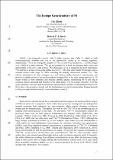Files in this item
The isotope geochemistry of Ni
Item metadata
| dc.contributor.author | Elliott, Tim | |
| dc.contributor.author | Steele, Robert C. J. | |
| dc.date.accessioned | 2018-09-07T13:30:05Z | |
| dc.date.available | 2018-09-07T13:30:05Z | |
| dc.date.issued | 2017-01-01 | |
| dc.identifier | 255735846 | |
| dc.identifier | cb89dbb7-179a-4fc6-b588-846a69073fab | |
| dc.identifier | 85020390515 | |
| dc.identifier.citation | Elliott , T & Steele , R C J 2017 , ' The isotope geochemistry of Ni ' , Reviews in Mineralogy and Geochemistry , vol. 82 , no. 1 , pp. 511-542 . https://doi.org/10.2138/rmg.2017.82.12 | en |
| dc.identifier.issn | 1529-6466 | |
| dc.identifier.uri | https://hdl.handle.net/10023/15990 | |
| dc.description | In the writing of this review TE was supported by the ERC (AdG 321209 ISONEB) and RCJS by ETH. | en |
| dc.description.abstract | Nickel is an iron-peak element with 5 stable isotopes (see Table 1) which is both cosmochemically abundant and rich in the information carried in its isotopic signature. Significantly, 60Ni is the radiogenic daughter of 60Fe, a short-lived nuclide (t1/2 = 2.62 Ma; Rugel et al. 2009) of a major element. 60Fe has the potential to be both an important heat source and chronometer in the early solar system. 60Ni abundances serve to document the prior importance 60Fe and this is a topic of on-going debate (see Extinct 60Fe and radiogenic 60Ni). The four other stable Ni nuclides span a sizeable relative mass range of ~10%, including the notably neutron-rich nuclide 64Ni. The relative abundances of these isotopes vary with diverse stellar formation environments and provide a valuable record of the nucleosynthetic heritage of Ni in the solar system (see Nucleosynthetic Ni isotopic variations). Ni occurs widely as both elemental and divalent cationic species, substituting for Fe and Mg in common silicate structures and forming Fe/Ni metal alloys. The Ni isotope chemistry of all the major planetary reservoirs and fractionations between them can thus be characterized (see Mass-Dependent Ni isotopic Variability). Ni is also a bio-essential element and its fractionation during low-temperature biogeochemical cycling is a topic that has attracted recent attention (see Mass-Dependent Ni isotopic Variability). | |
| dc.format.extent | 31 | |
| dc.format.extent | 1412025 | |
| dc.language.iso | eng | |
| dc.relation.ispartof | Reviews in Mineralogy and Geochemistry | en |
| dc.subject | QD Chemistry | en |
| dc.subject | GE Environmental Sciences | en |
| dc.subject.lcc | QD | en |
| dc.subject.lcc | GE | en |
| dc.title | The isotope geochemistry of Ni | en |
| dc.type | Journal item | en |
| dc.contributor.institution | University of St Andrews. School of Earth & Environmental Sciences | en |
| dc.identifier.doi | 10.2138/rmg.2017.82.12 | |
| dc.description.status | Peer reviewed | en |
This item appears in the following Collection(s)
Items in the St Andrews Research Repository are protected by copyright, with all rights reserved, unless otherwise indicated.

